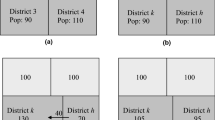Abstract
The problem of dividing political territories in electoral process is a very important factor which contributes to the development of democracy in modern political systems. The most significant criteria for fairness of electoral process are demographic, geographic and political. Demographic criterion in the first place refers to the population equality, while the geographic one is mostly represented by compactness, contiguity and integrity. In this paper we propose a new integer linear programming formulation for the problem of political districting. The model is based on the graph representation of political territory, where territorial units are vertices and direct links between them are edges. The correctness of integer linear programming formulation is mathematically proven. In contrast to the most of the previous formulations, all three major criteria, population equality, compactness and contiguity, are completely taken into consideration. There are two models, one which deals with afore mentioned criteria where compactness is taken as an objective function, and the other one which takes into account interests of the decision maker, i.e. the political ruling body which organizes elections. Several numerical examples for the presented models are given which illustrate general aspects of the problem. The experimental results are obtained using CPLEX solver.







Similar content being viewed by others
References
Bozkaya, B., Erkut, E., & Laporte, G. (2003). A tabu search heuristic and adaptive memory procedure for political districting. European Journal of Operations Research, 144, 12–26.
Duque, J., Church, R., & Middleton, R. (2011). The p-regions problem. Geographical Analysis, 43, 104–126.
Duque, J., Ramos, R., & Surinach, J. (2007). Supervised regionalization methods: A survey. Regional Science Review, 30, 195–220.
Garfinkel, R., & Nemhauser, G. (1970). Optimal political districting by implicit enumeration techniques. Management Science, 16, 495–508.
Giannuli, A. (1993). Vademecum referendum: tutto quello che vorreste sapere sulle leggi elettorali. I libri dell’Altritalia, Libera informazione editrice, http://books.google.rs/books?id=noyAMwEACAAJ, (in Italian)
Grilli di Cortona, P., Manzi, C., Pennisi, A., Ricca, F., & Simeone, B. (1999). Evaluation and optimization of electoral systems. In P. L. Hammer (Ed.), SIAM monographs in discrete mathematics. Philadelphia:SIAM.
Harrary, F. (1994). Graph theory. New York: Addison-Wesley.
Hess, S., Weaver, J., Siegfelatt, H., Whelan, J., & Zitlau, P. (1965). Nonpartisan political redistricting by computer. Operations Research, 13, 998–1006.
Hojati, M. (1996). Optimal political districting. Computers & Operations Research, 23, 1147–1161.
Kalcsics, J., Nickel, S., & Schröder, M. (2005). Towards a unified territorial design approach—Applications, algorithms and gis integration. TOP, 13, 1–74.
Li, Z., Wang, R., & Wang, Y. (2007). A quadratic programming model for political districting problem. In Proceedings of the first international symposium on optimization and system biology—OSB. Lecture Notes in Computer Science (Vol. 2664, pp. 144–157). Springer.
Mallozzi, L., & Puerto, J. (2018). The geometry of optimal partitions in location problems. Optimization Letters, 12, 203–220.
Mehrotra, A., Johnson, E., & Nemhauser, G. (1998). An optimization based heuristic for political districting. Management Science, 44, 1100–1114.
Nemoto, T., & Hotta, K. (2003). Modelling and solution of the problem of optimal electoral districting. Communications of the OR Society of Japan, 48, 300–306. (in Japanese).
Nygreen, B. (1988). European assembly constituencies for Wales. Comparing of methods for solving a political districting problem. Mathematical Programming, 42, 159–169.
Ricca, F., Scozzari, A., & Simeone, B. (2008). Weighted Voronoi Region Algorithms for Political Districting. Mathematical and Computer Modelling, 48, 1468–1477.
Ricca, F., Scozzari, A., & Simeone, B. (2013). Political districting: From classical models to recent approaches. Annals of Operations Research, 204, 271–299.
Shirabe, T. (2005). A model of contiguity for spatial unit allocation. Geographical Analysis, 37, 2–16.
Shirabe, T. (2009). Districting modeling with exact contiguity constraints. Planning B: Planning and Design, 36, 1053–1066.
Tang, X., Soukhal, A., & T’kindt, V. (2014). Preprocessing for a map sectorization problem by means of mathematical programming. Annals of Operations Research, 222, 551–569.
Acknowledgements
This research was partially supported by Serbian Ministry of Education and Science under the Grant No. 174010.
Author information
Authors and Affiliations
Corresponding author
Additional information
Publisher's Note
Springer Nature remains neutral with regard to jurisdictional claims in published maps and institutional affiliations.
Rights and permissions
About this article
Cite this article
Dugošija, D., Savić, A. & Maksimović, Z. A new integer linear programming formulation for the problem of political districting. Ann Oper Res 288, 247–263 (2020). https://doi.org/10.1007/s10479-020-03559-y
Published:
Issue Date:
DOI: https://doi.org/10.1007/s10479-020-03559-y




